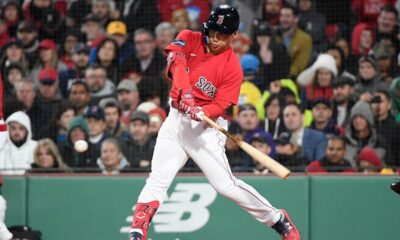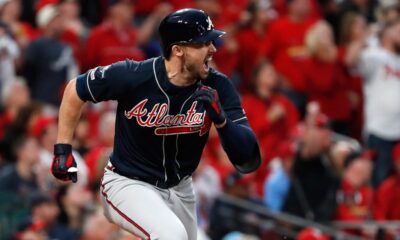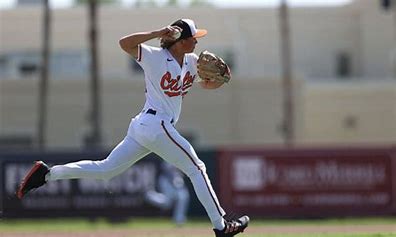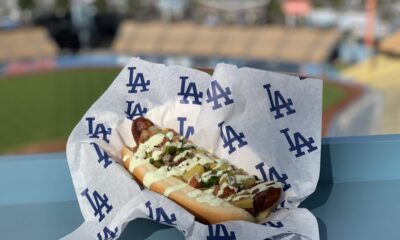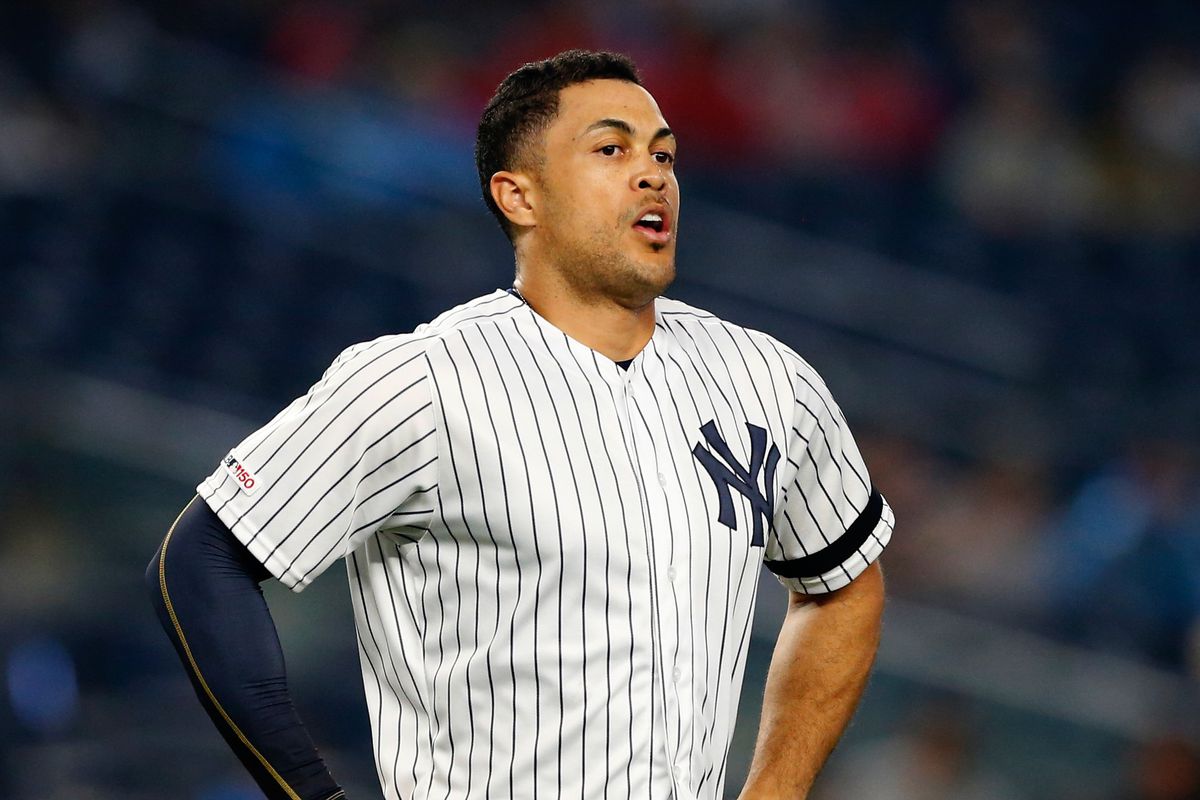
Note: There are some advanced stats in this article, so please check out the key at the end.
Giancarlo Stanton. His name brings up a lot of fond memories. He is the man formerly known as Mike Stanton, the six-foot six behemoth, the home run derby winner with legendary bat speed, and a New York Yankee. Trade candidate? That part about Stanton does not come up too often nowadays. Look at Bleacher Report, ESPN, MLB.com, The Athletic; there is nothing about Stanton as a trade candidate. In fact, the idea only came to fruition when a friend who does not know too much about the Yankees asked, “When are the Yankees trading Stanton?” It’s not really a matter of when. The real question is why aren’t the Yankees considering trading Stanton?
Cap space, a rotating DH, room to add a marquee free agents, and not needing a big bat like him in the lineup are all reasons to trade Stanton. Furthermore, when Stanton performed below expectations in 2018 in New York (despite hitting 38 HRs, 100 RBIs with a .842 OPS, and 4.3 fWAR) there were non-stop rumors that the Yankees were thinking about trading Stanton. So what changed? In short, he got injured. A left bicep strain and a right knee sprain sidelined Stanton for all but 18 games in 2019. Oh, and don’t forget the Yankees also had to pay the slugger a whopping $26 million. 2019 was a crucial year for Stanton. Unfortunately, because of his injuries, he never got the chance to prove that he was still the same player who won the NL MVP in 2017. As a result, his trade value plummeted, as did the trade rumors. Very few teams can take on his remaining eight year, $218 million contract, and even among those teams, there may not be a lot of interest. Still, trading Stanton makes too much sense for the Yankees to not at least explore the idea. Perhaps with the right deal, maybe, just maybe, a team will bite.
Stanton’s contract is currently the largest contract on the Yankees roster and makes it difficult for the Yankees to fall under the luxury tax threshold in 2020. The luxury tax was essentially insignificant to the Yankees throughout the 2000s. In Major League Baseball, the luxury tax, is a way to keep big market teams in check, and try to keep them under a certain payroll. Those that go above the payroll are taxed on every dollar spent above the allocated budget. However, the Yankees always had about double the amount of revenue coming in than their payroll. Even when the Yankees far surpassed the luxury tax threshold, and were taxed fifty percent on every dollar spent above the budget, they still were making bank. Every. Single. Year.
However, under the new Collective Bargaining Agreement (CBA) that began in 2017, the luxury taxed changed. Not only would teams be taxed if they went over budget, but their draft pick selection in the June Amateur Draft would drop ten places. Since 2017, finally big market teams like the Yankees were afraid of the luxury tax. In 2018, the Yankees fell below the luxury tax for the first time since the luxury tax was put into place. Despite this milestone victory, the Yankees went more than $15 million over the luxury tax threshold in 2019. Since they are $1.6 million away from the threshold in 2020, they are a sure bet to exceed the cap once again.
Consequently, the Yankees are desperate for at the very least a World Series appearance in 2020. Even though the Yankees were an 103-win team in 2019, Aaron Judge described their postseason woes best when he said, “The season was a failure.” This is reminiscent of George M. Steinbrenner days, where the controversial owner’s philosophy was World Series title or bust. General Manager Brian Cashman understands this pressure very well as the Yankees are looking to make their first huge free agent starting pitcher splash since Masahiro Tanaka during the 2013-14 offseason. Cashman’s eye is on Gerrit Cole, the cream of the crop amongst free agent starting pitchers. Cole was once drafted by the Yankees before spurning them for a college education and more time to harness his skills, which allowed him three years later to be a first round pick for the Pittsburgh Pirates. Recently retired Yankee pitcher, CC Sabathia, who once received the highest contract of all time for a pitcher (seven years for $161 million), chimed in; “If you give that motherf—er enough money, he’s going to want to come here… I’m speaking from experience. You offer him enough money he’ll pitch on the moon.”
Cole, fresh off a 326 strikeout season (an Astros single-season record), and just 29 years old, looks to become the new highest paid pitcher of all time. Currently, Zack Greinke of the Houston Astros has the all time highest average annual value (AAV) at $34.4 million, while David Price of the Boston Red Sox has the highest contract at seven years, $217 million. Cole’s camp is shooting for the moon by trying to become the first pitcher with a $300 million dollar contract. That being said, Cole will almost certainly have a higher AAV than Greinke, and make more money than Price. A realistic potential contract for Cole could be a seven-year deal worth $245 million ($35 million per year). Thus, if the Yankees get rid of Stanton’s current contract, Cole would be a lot more affordable.
Although the Yankees starting rotation ranked 15th in ERA (4.51) and 26th in innings pitched (slightly under five innings per outing), they have a surprising amount of talent in their rotation. Luis Severino placed third in the AL Cy Young in 2017 and ninth in the AL Cy Young in 2018. James Paxton has ace-like potential and finished the last two months very strong. J.A. Happ will have a difficult time being worse than last year, and he showed legitimate upside in September. Meanwhile, Tanaka remains a solid #3 starter, with #2 starter potential, while always pitching like an ace in the postseason. Now imagine the Yankees add Gerrit Cole to the rotation; the 1-2 punch of Cole and Severino alone would compete with Justin Verlander and Zack Greinke (Houston Astros), Max Scherzer and Patrick Corbin (Washington Nationals), Clayton Kershaw and Walker Buehler (Los Angeles Dodgers), Corey Kluber and Shane Beiber (Cleveland Indians), and Jacob deGrom and Noah Syndergaard (New York Mets) as the best in baseball. Besides, the rotation would be rounded out by Tanaka, Paxton, and Happ with Jordan Montgomery, Delvi Garcia, Domingo German (pending a domestic violence suspension), Jonathan Loaisiga, Michael King, and Nick Nelson are all right behind the starting five. Therefore, by acquiring Cole, they might have one of the better rotations in all of baseball.
Even if the Yankees do not end up signing Cole, or another stud starting pitcher by the name of Stephen Strasburg (who might command $30 million or more per year), they still might want to clear up some payroll space after 2020. Despite a lot of money coming off the books in 2021 (Tanaka-$26 million, Jacoby Ellsbury-$26 million, including his $5 million buyout, Happ-$17 million if he does not start 27 games or pitch 165 innings in 2020, Zack Britton-$13 million if he opts out of his contract, and DJ LeMahieu-$12 million), the Yankees will probably re-sign Tanaka and LeMahieu, while it would be unlikely that Britton opts out of his contract considering he has a $14 million 2022 club option. Additionally, the money the Yankees spend will rise significantly after the 2020 season. The Yankees are projected to spend about $20 million on current arbitration eligible players and on 2021 arbitration eligible players. These players include, but are not limited to, James Paxton, Aaron Judge, Gary Sanchez, Gleyber Torres, Miguel Andujar, Tommy Kahnle, Gio Urshela, Chad Green, and Luke Voit. Each year arbitration eligible players make a lot more than they did the year before; thus, this same $20 million group would cost the Yankees an estimated $46.5 million in 2021, a $26.5 million difference. Just for equal measure, Stanton’s 2021 salary is $29 million, so getting rid of his contract alone would help offset the amount of money due to these arbitration eligible players.
For a brief moment, let’s forget about the Yankees payroll situation. Hitting wise, do the Yankees even need Giancarlo Stanton? Obviously Stanton would add additional pop to the lineup and is an incredible player, but the Yankees surprisingly did just fine without Stanton in 2019. They had a single season high in home runs with 306 dingers (MLB average was 226 homers), scored an absurd 5.82 R/G (MLB average was 4.83 R/G), and had a .829 OPS (MLB average was .757 OPS). Their hitting should be just as good, if not better, as they are bringing back pretty much the same group of sluggers.
That being said, the Yankees already have a lot of hitters that can fit nicely in Stanton’s role as a DH. Players such as Luke Voit, who in 118 games had a triple slash line of .263/.378/.464 with 21 HRs, .200 ISO, 126 wRC+. Meanwhile, defensively Voit had -6 DRS, and -3.9 UZR, all leading to a 1.7 fWAR. Then there’s Mike Ford, who in 50 games had a triple slash line of .259/.350/.559 with 12 HRs, .372 wOBA, 134 wRC+. Defensively, Ford struggled with -1 DRS and -1.5 UZR, but still altogether accumulated 0.8 fWAR. Also, Clint Frazier in 69 games hit .267/.317/.489 with 12 HRs, 108 wRC+. Defensively, Frazier accumulated -8 DRS, -5.2 UZR, and 0.1 fWAR. The injury prone Gary Sanchez, who has never played more than 122 games in a season, hit .232/.316/.525 with 34 HRs, .293 ISO, and 116 wRC+ in 106 games in 2019. On the receiving end, Sanchez had -2 DRS, -6.8 FRM, 23.4 CS%, all leading to a 2.3 fWAR. Lastly, returning slugger Miguel Andujar, who played in 149 games in 2018, hit .297/.328/.527 with 27 HRs, .230 ISO, and 130 wRC+. However, Andujar struggled immensely with the glove as he had -25 DRS and -25.4 UZR/150 despite accumulating a 2.8 fWAR.
Besides taking struggling defenders off the field, trading Stanton opens a vacancy for the DH role. Consequently, the Yankees can have a DH by committee, allowing an additional slugger on the Major League roster (like Clint Frazier) as well as giving them space to monitor position battles. These battles include third base (Gio Urshela and Miguel Andujar), first base (Luke Voit, Mike Ford, Miguel Andujar), and outfield (Mike Tauchman, Clint Frazier, and potentially Brett Gardner). Having roster competitions benefits both the team, and the players themselves. The team gets a closer look at who deserves to start, while the players become motivated to compete against one another. Players that do not win the position battle can either spend time as a DH or as a bench player. Thus, the DH by committee would be a win-win situation for the Yankees if they were able to trade Stanton.
There’s been a lot of discussion so far about the benefits of the Yankees trading Stanton. Consequently, the likelihood of Stanton being traded needs to be addressed. First of all, even if the Yankees did trade Stanton, he might stop the Yankees from trading him. Stanton has a full no-trade clause, meaning that he can bar a trade to any team if he so desires. In fact, Stanton enforced his no-trade clause when the Miami Marlins tried to ship him off to the Boston Red Sox and St. Louis Cardinals back in the 2017-18 offseason. As Stanton has utilized his no-trade clause before, he is likely to do it again, especially since he’s already on a big market team. Secondly, Cashman has not really answered, nor made any remarks about trading Stanton. Cashman has strongly demonstrated his stance on acquiring a starting pitcher, as well as the futures of free agents Brett Gardner, Dellin Betances, and Didi Gregorius. Accordingly, if trading Stanton was a priority, Cashman would most likely hint at such an idea. Thirdly, there is not really too much of a market for Giancarlo Stanton mostly because of financial flexibility, desire to acquire a potent outfield/DH slugger, and diminished trade value. In fact, only four teams seem to be a match for Stanton. These teams are the Chicago White Sox (~$134 million cap space), San Francisco Giants (~$74 million cap space), Texas Rangers (~93 million cap space), and the Los Angeles Angels (~68 million cap space).
Besides having cap space, these four teams also might have interest in Stanton as an outfielder or DH. The White Sox currently have outfielders Eloy Jimenez, Daniel Palka, Adam Engel, Luis Alexander Basabe, Leury Garcia, Micker Adolfo, and Blake Rutherford on the forty-man roster. The most productive outfielder of the bunch is Eloy Jimenez, who had an excellent rookie season in 2019 (31 HRs, .267/.315/.513, .243 ISO, 116 wRC+, 1.9 fWAR). Meanwhile, Engel and Garcia are speed and defense first outfielders, whereas Basabe will certainly get some playing time considering he was the prized prospect of the Adam Eaton trade. Then there’s Palka, who is a year removed from a 27 homer rookie campaign. There’s talent in the White Sox outfield, but Stanton would almost certainly be a major upgrade and a major improvement in right field. The White Sox recently signed catcher Yasmani Grandal to the largest contract in franchise history (four years, $73 million). Additionally, the White Sox are interested in Zack Wheeler, whose contract could quite possibly be more expensive Grandal’s four year deal. The White Sox are a team that is looking to compete, and are opening their checkbook left and right. That being said, Stanton would perfectly fit the White Sox’s contention-driven agenda.
Out of the four teams, the Giants would be the most likely to trade for Stanton. They were in the mix for the slugger when the Marlins were shipping him off in 2017-18 offseason. Stanton, a resident of Panorama, California, also might not veto a trade to a big market area like San Francisco. Furthermore, the Giants have a major hole in right field. Their outfield currently consists of Mike Yaztremski (.272/.334/.518, 21 HRs, 121 wRC+, 8 DRS, 0.8 UZR, 2.2 fWAR), and Kevin Pillar (.259/.287/.432, 21 HRs, 85 wRC+, -3 DRS, -0.6 UZR/150, 1.5 fWAR) can occupy left and center field respectively. Stanton would be a significant upgrade to the outfield not only because of his offensive and defensive prowess, but also because he is a lot better than the combination of Joey Rickard, Austin Slater, and Steven Duggar. The Giants surprised a lot of people with a 77-win season in 2019, while also being in the NL Wild Card mix for some time in the second half. Also, the Giants are unsure about a full-on rebuild, or trying to contend in 2020. As a result, Stanton would justify their ambition to contend in 2020.
Then there’s the Texas Rangers. The Rangers surprised a lot of people as they won 78 games and were in the AL Wild Card hunt in the first half. The Rangers could use a DH and are thinking about trading current right fielder Nomar Mazara. The Rangers are trying to free up playing time for the diminutive Willie Calhoun, who will share RF and DH duties with Shin-Soo Choo. However, Choo is off the books in 2021, so the Rangers can afford another player that can split RF and DH duties with Calhoun. This could allow an open spot for Stanton and would instantly improve their offense that ranked 12th in baseball. In the meantime, the Rangers can shift the powerful corner outfielder Joey Gallo to center field or a corner infield position, where he also played in 2019. Gallo shifting positions for a year would be more than worthwhile if Stanton can be added to the team and give the Rangers their first playoff berth since 2016.
Lastly, the Los Angeles have an open spot in right field that Stanton can fill. With Justin Upton in left field and 2019 MVP Mike Trout in center, the Angels would have one of the best outfields in all of baseball. Meanwhile, top prospect Jo Adell can begin the season in Triple-A and come up as a fourth outfielder when ready. Additionally, Albert Pujols will be finished with the Angels by 2021, in which case Stanton can take over mainly as a DH. However, the Angels are primarily focused on acquiring starting pitching, especially pitchers like Gerrit Cole and Stephen Strasburg. Still, if the Angels miss out on the two big starters, they can open up their checkbook for a player like Giancarlo Stanton. Either way, the Angels are trying to give Trout just his second playoff berth since his tenure on the Angels, and adding Stanton would certainly help.
With all these potential suitors in mind, what would a trade look like for Giancarlo Stanton? Well, this trade would be quite similar to the Stanton trade to the Yankees. The Marlins, in return for Stanton, received Starlin Castro as well as his eight figure contract, a top-30 Yankee prospect in Jorge Guzman, and a low-level prospect in Jose Devers. The Yankees will also receive $30 million from the Marlins, if Stanton opts-out of his contract in 2020 (which probably won’t happen as there is little chance he can receive more money from another team). That being said, a good starting point would be the Yankees paying $40 million, or $5 million per year to the team Stanton gets traded too. Also, the Yankees should at least be able to get two prospects from each team’s top thirty prospect list. The Yankees can always use some more pitching and middle infield prospect to eventually replace Tyler Wade as a potential backup infielder.
Therefore, the Yankees could probably get LHP Lenyn Sosa (#30 prospect), and SS Bernardo Flores (#28 prospect) from the White Sox. Sosa is 19 years of age, has blossoming power, and a strong arm. Additionally, Flores has a fastball that misses bats, and a solid changeup after a strong season in Double-A. In a trade with the Giants, the Yankees could receive SS Abiatal Avelino (#27 prospect), and LHP Seth Correy (#9 prospect). Avelino, a former Yankee prospect, has double digit pop and speed, as well as a high batting average. He can join the big league team almost instantly after a strong season in Triple-A. Also, Correy, who has a big curveball, and straight off a great Single-A season could potentially become a future starter in the long run. In a trade with the Rangers, the Yankees should be able to acquire INF Eli White (#30 prospect) and LHP Taylor Hearn (#27 prospect). White, who is 25 years of age, is expendable as he is quite old for a prospect. He also had double digit pop, and speed in Triple-A last year and could be a nice replacement for Tyler Wade. Meanwhile, Hearn has a hard fastball with a decent slider and changeup. He can fit nicely into the Yankees bullpen at some point in 2020. Lastly, the Yankees could receive RHP Robinson Pena (#27 prospect) and SS/2B Leonardo Rivas (#25 prospect). Pena’s 6-4, 180 pound frame allows him to have good projectability, especially with a splitter than can induce a lot of ground balls in Yankee Stadium. Also, Rivas is a defensively minded middle infielder with a great batting eye and has room to grow as he looks to play in Double-A in 2020.
In reviewing the pros of trading Stanton, as well as taking a closer look at potential suitors for him, the Yankees have everything to gain by making a trade. The White Sox, Giants, Rangers, and Angels can all afford, and benefit greatly from, having Stanton on their team. In all likelihood the Yankees will not trade their star slugger, but they should at the very least explore the possibility as there would be so many advantages for the team moving forward.
Key:
DH: Designated Hitter
NL: National League
AL: American League
HR: Home Run
RBI: Run Batted In
R: Runs
fWAR: Fangraphs Wins Above Replacement. If a player has 0.1 fWAR they are worth 0.1 wins more than a replacement level player (0.0 fWAR). A average starting player that plays most of the season usually has an fWAR of 2.0.
ERA: Earned run average. The average nimber of runs a pitcher gives up in a nine-inning game. MLB average in 2019: 4.49 ERA.
Cy Young: The award for the best pitcher in each league
R/G: Runs per game. MLB average in 2019: 4.83 R/G.
AVG(BA)/OBP/SLG:The triple slash line of Batting Average (Hits/At Bats), On Base Percentage (Hits+Walks+Hit by Pitches/Plate Appearances), and Slugging Percentage (Singles+Doubles*2+Triples*3+Home Runs*4). MLB average in 2019: .252/.323/.435
OPS: OBP+SLG. MLB average in 2019: .757 OPS
ISO: Isolated Power. (Doubles*1+Triples*2+Home Runs*3)/At Bats. MLB average in 2019: .183 ISO
wRC+: Weighted runs created plus. A stat that quantifies total offensive value and factors in the different dimensions of each ballpark. A wRC+ of 100 is replacement and anything above that is X% above league average (i.e. a wRC+ of 101 is 1% above league average offensively)
DRS: Defensive Runs Saved. A DRS above 0 is above average, and a number below 0 is below average.
UZR: Ultimate Zone Rating. A defensive stat where a number above 0 is above average, and a number below 0 is below average.
UZR/150: UZR over the course of 150 games played (a healthy season for a starting player)
wOBA: Weighted On Base Average. A more advanced version of OBP. MLB average: .320 wOBA.
FRM: Number of runs saved for catchers. Above 0 is above average and below 0 is below average.
CS%: Caught Stealing Percentage. MLB average in 2019: 28.94 %
RF: Right Fielder
R/LHP: Right Handed Pitcher or Left Handed Pitcher
SS: Shortstop
2B: Second Base
INF: Infielder
Sources:
https://www.baseball-reference.com/players/s/severlu01.shtml
Related

Featured Articles
-
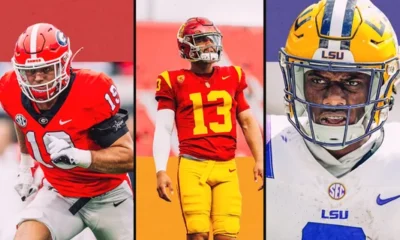

College Football
/ 10 hours ago2024 Back Sports Page NFL Mock Draft
2024 BSP Mock Draft Last year, we let all of our football writers become...
By Mason Wood -
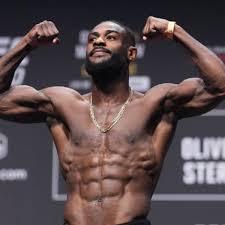

MMA
/ 15 hours agoNext Chapter: Aljamain Sterling
On a historic night for the UFC, one of the more decorated champions of...
By Brandon Li -
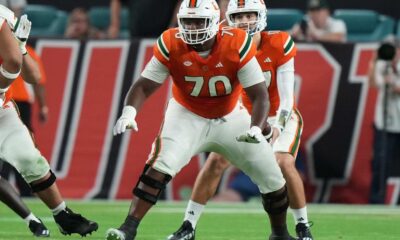

College Football
/ 20 hours agoNFL Draft 2024 Scouting Report: Javion Cohen, OG, Miami
Javion Cohen, OG, Miami Height: 6’4” Weight: 319 Arm Length: 33 ⅞ 40-Yard...
-
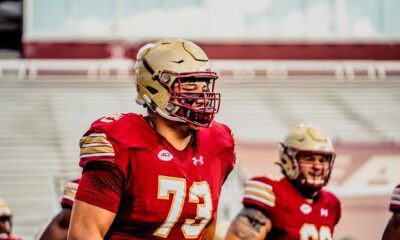

College Football
/ 20 hours agoNFL Draft 2024 Scouting Report: Christian Mahogany, OG, Boston College
Christian Mahogany, OG, Boston College Height: 6’3” Weight: 314 Arm Length: 33 ½ ...
